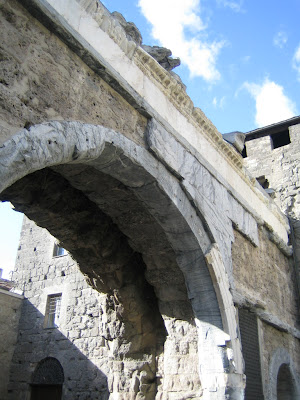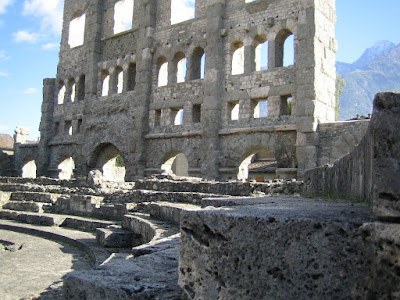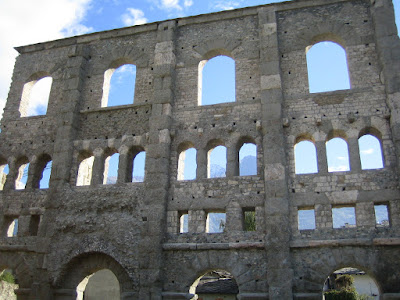Aosta: The Alpine Rome - A Travel Guide
Aosta, the Rome of the Alps, lies some one hundred and ten kilometres north-northwest of Turin and is the principal town of the Valle d'Aosta. Surrounded by mountains, Grand Combin and Mont Vélan to the north, Becca di Nona and Monte Emilius to the south and Testa del Ruitor to the west.
Aosta's Roman past is clearly visible, parts of the city walls, constructed with river rock and covered by travertine blocks, the Arch of Augustus, the Pretorian Gate and the Roman Theatre are historic gems. The Valle d'Aosta region is ruled by a special statute where the Italian and French languages are both officially recognised, so street signs are bilingual and many place names and local family names are of French origin. In the historic centre the characteristic side streets known as "ruelle" conceal many hidden courtyards and corners where today boutiques, book stores, cafés, design shops and restaurants add to the atmosphere.
Aosta's Top Ten Tips:
1) View the triumphal Arco di Augusto, built in 35 BC, the symbol of Aosta
2) Marvel at the four thousand seat Teatro Romano begun in the first century AD
3) See the La Cattedrale di Aosta with its ivory diptych dating from A.D. 40
4) Walk through the Porta Praetoria, a double gate with three arches flanked by two towers
5) Nearby is the Torre dei Signori di Quart, a twelfth century tower house
6) Check out the Roman Amphitheater which once accommodated 20,000 spectators
7) See the Romanesque-Gothic Collegiata dei Santi Pietro e Orso founded in the late tenth century
8) Stroll along the Via Sant'Anselmo, Aosta's main pedestrian street
9) Tour the towers: Tour du Baillage, Tour du Lépreux, Tour du Pailleron, Tour Fromage and Tour Neuve
10) Walk across the perfectly preserved Roman bridge to the east of the city

Aosta's Events and Festivals:
In January there are two events, the "Sant'Orso" Fair", a colourful celebration of the town's beloved saint, where artists and craftsmen from the Aosta Valley exhibit their work, bringing thousands of visitors to Aosta from nearby France and Switzerland as well as various regions of Italy and many others parts of Europe. Then there is the "Carnaval des Montagnes" a parade particularly enjoyed by the locals who wear beautiful masks.
In August the "Foire d'Eté" (Summer Fete) offers visitors the opportunity to view and purchase local crafts, whilst in September the Festival degli Artisti di Strada (International Festival of Street Artists) enlivens the city. Finally in October (next-to-last Sunday of the month) the "Bataille de Reines" (Battle of the Queens) which is one of the most important events in Valle d’Aosta where cows "compete" for the position of matriarch of the herd.

Aosta's Food and Drink:
Typical local dishes include: Zuppa Valdostana (Cabbage and Cheese Soup), Costoletta alla Valdostana (Veal Chop with Fontina) and Capriolo alla Valdostana (Venison stewed in red wine with vegetables, herbs, grappa and cream). Vines have been cultivated in the Aosta Valley since Roman times and possibly before. Today the region is home to some of Italy's newest DOC appellations, Blanc de Morgex, Donnas, Enfer d’Arvier, Nus Rouge, Nus Malvoisie and Torrette.

Aosta Must do: "Teatro Romano"
Begun in the first century AD, the Teatro Romano in Aosta shows that even at this distance from Rome, culture was never far away from daily Roman life. Today, the twenty-two metre high southern facade still stands, together with a semi-circular tiered area, 'the cavea' that hosted the guests and the foundation of the wall that acted as the backdrop, the 'scaena'. There is a train of thought that there was a permanent roof and it was certainly extended in the early years to accommodate some four thousand spectators. A truly remarkable insight into what was the theatre of Augusta Praetoria.

Aosta: how to get there:
By Plane:
The most convenient airports to Aosta are Milan and Turin. The Milan airport of Milano-Malpensa is about two hours, whilst the Aeroporto di Torino (Turin) is about 75 minutes. Both are well served by major airlines and budget ones such as Easyjet and Ryanair.
By Bus:
From Chamonix (France), 2 hours, twice a day
From Milan, 2½ hours, five a day
From Turin 2 hours, up to 4 daily
By Car:
From: Chamonix (France), about 60 km: N205, through Mont Blanc Tunnel, Autostrada A5 Torino, exit Aosta-Ovest.
From Milan, about 165 km: Autostrada A4 Milan - Turin, exit Santhia, take A5 for Aosta, exit Aosta-Est.
From Turin, about 120 km : Autostrada A5 Torino-Aosta, exit Aosta-Est.
By Train:
From Milan Centrale via Chivasso 4 hours, more than 10 daily. From Turin, 2 to 2½ hours, more than 10 daily.
At Aosta station there is a cable car to the resort of Pila which is joined to the station by a short pedestrian subway.
Adrian Petersen is the Piedmont and Valle d'Aosta Editor for Wandering Educators.
All photos courtesy and copyright Adrian Petersen
Note: this article was originally published in 2010 and updated in 2017
-

- Log in to post comments


















